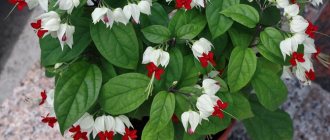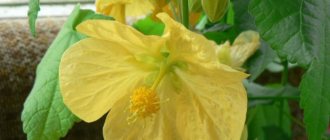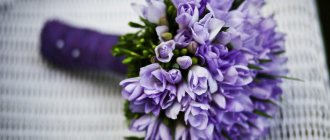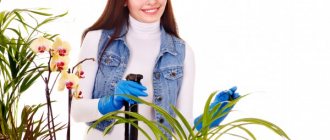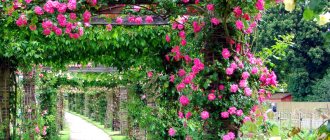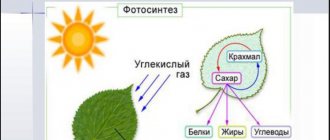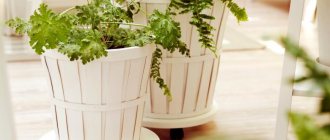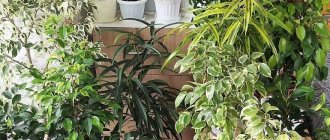What are home grown white flowers with a red center called?
A houseplant with white and red flowers is called clerodendrum. The complex name of this plant translates as “tree of fate.” There is a Javanese legend associated with it that clerodendrum brings happiness. A distinctive feature of these plants are their unusual flowers that take the shape of a butterfly.
Clerodendrum Thomson
Thomson's clerodendrum is a woody vine with fast-growing shoots. This plant is a rare guest in Russian apartments. The most common variety was Prospero. It is distinguished not only by its flowers, but also by its leaves, which look like thick branches. The aroma of blooming clerodendrum has jasmine notes - for this feature the vine was nicknamed “nodding jasmine” by the Japanese.
Description
Clerodendrum blooms in the summer season. The first flowers appear in June, and in September the plant begins to prepare for hibernation. But if we consider the Fragrant Clerodendrum, it is capable of blooming all year round with proper care. The aroma of the plant comes not only from the buds, but also from the leaves. The smell may vary depending on the variety.
The leaves of the vine reach a length of 20–30 centimeters. The shoots of the plant quickly become woody during the period of active growth.
Flower growers note the following features of clerodendrum:
- The shape of the bush is adjusted by pinching and pruning. The plant can be bush-like, ampelous or standard.
- The flower surprises with its unpretentiousness and endurance. During the dormant period, it does not freeze even at a temperature of twelve degrees.
- As the bush matures, it needs to be replanted less frequently. A young plant changes pots once a year. Mature - once every 3-4 years.
Care
During the growing season, clerodendrum needs periodic watering. It is necessary to spray the plant with a spray bottle in the evening. The bushes tolerate soft, settled water well. The frequency of watering is determined by temperature conditions. On hot summer days, the vine needs frequent watering. At other times, hydration is reduced. To determine a flower’s need for moisture, just look at the soil.
Important. In order for the flower to be preserved over the winter, it must be protected from all heating devices. Despite hibernation, clerodendrum may suffer from excessive dry air. Overdrying the earthen clod will result in the death of the plant.
Flower growers begin to fertilize clerodendrum in the second half of April. To saturate the plant with microelements, two feedings per month are enough. Complex fertilizer for flowering indoor plants is used as fertilizing. During the hibernation months, the bush does not need fertilizers.
Clerodendrum requires periodic pruning to adjust growth. Two types of pruning are applied to the plant:
- Rejuvenating. During rejuvenation, weak and dried shoots are removed. Healthy stems are shortened by a third to stimulate growth. If you follow the pruning rules, the bushes will produce young, fast-growing shoots. Inflorescences will begin to actively form on these shoots.
- Formative. A dense crown is the key to the health and beauty of the plant. If a gardener wants to turn clerodendrum into a bush, in the spring he will need to greatly shorten the stems. To give a flower a stem shape, it must be removed from all shoots except one - the strongest. To form the crown, all upper stems are pinched.
Clerodendrum needs frequent soil renewal. It quickly absorbs all nutrients and depletes the substrate. Another reason for replanting is that the pot is cramped: if there is not enough space, the plant will wither. The transplant should coincide with the beginning of the growing season. If the grower plans to prune the bush, this task must be completed before replanting.
The bush is suitable for fertile soils with a slightly acidic reaction. You can buy the substrate at the store or prepare it yourself.
The following components will be needed for the soil mixture:
- coarse sand;
- peat;
- clay and leafy soil.
Important. Before planting clerodendrum, the substrate must be disinfected. For these purposes, gardeners use ovens, ovens or microwaves.
When transplanting, the exact sequence of actions must be followed:
- A drainage layer 3 centimeters high is poured onto the bottom of the pot.
- The flower is lowered into the pot using the transfer method. During transplantation, you need to try not to damage the earthen ball.
- The voids in the pot are filled with prepared substrate.
- After compacting the earth, the bush is watered.
If the plant requires support, it is installed during transplantation. If you stick a stick into the soil mixture later, there is a risk of damaging the root system.
Reproduction of spathiphyllum
Reproduction occurs by dividing the bush and seeds. It is very convenient to perform this procedure during transplantation. You need to divide the plant very carefully so as not to damage anything, otherwise the cuttings will not take root.
Seeds
A rather advantageous feature of red spathiphyllum is that it can be grown from seeds. However, in order for them to form, it will be necessary to take care of this initially.
It is necessary to carry out the process of pollination of flowers. It involves the transfer of pollen from one flower to another. To perform this operation, you will need a swab with a cotton tip or a brush with a certain softness. Pollination manipulations should be repeated several times over several days. Patient housewives will wait for the formation of colorful berries 10-11 months after the operation. However, in this matter you should still be patient until the seeds form.
To do this, the seeds need to be removed from the berries and washed under running water. Then you should make a 0.1% solution of potassium permanganate. Seeds are sent into it to prevent mold from growing on them. They should remain in the solution for 2 hours.
Since the seeds lose their ability to germinate within a short time, they must be sent to a shallow container, the bottom of which is covered with slightly damp foam rubber. The top of the vessel should be covered with a plastic bag or glass lid. After germination, the seeds need to be planted. This procedure must be performed 3 or 4 times. Picking is done in a high-quality soil mixture. Seedlings should be placed at a distance of 1.5 cm from each other each time.
After the seedling reaches 7-8 cm, you need to transplant it one last time. A vessel with a volume of 0.2 liters will be suitable for the flower. With proper care, the seedling will begin to actively grow and will require another transplant in 11-12 months.
Dividing the bush
The resulting cuttings should not have wilted leaves: they should be cut off immediately. If there are no roots when dividing, then the plant should be placed in water for 3 weeks and wait until it takes root. The length of the roots should be at least 2-3 cm, then the plant can be planted in the soil. If you do not need the plant to grow too much, then on the division you need to leave one growth point and a rhizome.
It is better to divide at a warm air temperature: +20-21 °C.
Make sure that each rhizome has several leaves: at least 2-3. The delenka needs to be planted in a pot whose diameter will be 15 cm, no more. The pot must first be filled with the substrate described above. Carefully observe all proportions. Some gardeners also recommend the following substrate: leaf soil, coniferous soil, a layer of humus, peat and sand. The ratio is as follows: 2:2:2:2:1.
Flowers with large leaves
Flowers that differ in the size of their leaves include:
- Anthurium. The leaves of this plant reach a length of 30 centimeters. Flowers with a yellow erect inflorescence and a bright red petal that resembles a sail. Anthuriums are light-loving flowers that do not get along with drafts and coolness.
- Spurge. Euphorbia leaves are dark green in color. Their length ranges from 10 to 15 centimeters. The deep red petals are shaped like the pointed leaves. This plant blooms during the winter months.
- Vallota. Wallot leaves are pointed and sword-shaped. They can reach half a meter in length. They come in a dark green shade, which turns into dark red towards the base. With proper care, the plant blooms twice a year.
- Clerodendrum. The leaves of the plant grow up to 30–35 centimeters and have the shape of a vine. The plant itself has become famous due to the unusual color of its flowers, which combines red and white.
Leaves, flowers and fruit
Vriesia leaves form a funnel, which has the properties of a tank. More precisely, it is formed by the sheaths of leaf plates; they form a container where accumulated moisture enters. This function is vital for perennials even at home. Some wild specimens have “cisterns” in funnels up to 5 liters. The leaf blade is dense to the touch, leathery, most often solid green. The leaf shape is xiphoid with a pointed tip. There are species with leaf blades of variegated color, with spots, stripes or with a marbled coating. You can also find simple or branched leaves. The plate can reach up to 80-100 cm, both in nature and in indoor flowers.
The flowers are small; they form in bracts and die quickly. The buds are covered with bract petals of green or other bright shade. The most common inflorescences are red, orange, deep yellow or white. Due to the slight similarity of not many species during the flowering period, due to the consonance of names, they are often confused with Freesia from the Iris family. The inflorescences are located on tall peduncles, equal in length to the leaves or from 50 to 90 cm. A spike of small flowers and bract petals reaches 15 cm.
After flowering, the indoor Vriesia flower quickly sets seeds. The fruit forms a capsule with tufted planting material. It remains viable for a long time, so it is often used for plant propagation.
How to care for poinsettia after flowering
So, you have already realized that after shedding the red “leaves”, the poinsettia does not die at all, even if outwardly it looks completely lifeless, it simply begins a pronounced dormant period.
This means that the plant needs help:
- gradually reduce watering to a minimum;
- when the leaves fall off completely, trim the bush to a height of 10-15 cm;
- place the pot in a cool, dark place, water a little into the tray about once every two to three weeks;
- after about two months, in May, transplant the “Christmas star” by transferring it into a larger container;
- Place the poinsettia in the new pot in its usual bright location and begin to resume watering until new shoots appear.
You shouldn’t leave too many new shoots – 3-4 of the most beautiful, strong and healthy ones are enough. You can use the removed shoots for cuttings - poinsettia propagates quite easily in this way.
Proserpinaka palustris
Proserpinaka palustris is a stunningly beautiful plant with serrated orange-red leaves. When growing above water, the plant turns green.
Maintaining proserpinac is generally not difficult. This is a marsh plant, so it likes silted gravel. Medium to high lighting will do. The stronger the light and the more nutrients, especially nitrogen and phosphates, the more colorful the leaves will be.
The plant is small and grows slowly, suitable for foreground and middle ground decoration.
Vriesea carinata
The second most popular indoor species is the keeled Vriesea carinata. The perennial epiphyte received this name due to the sharp keel of its xiphoid leaves. The species is considered dwarf, since in adulthood it reaches no more than 25 cm in height, not including the flower stalk. The leaves are bright green, rich in color, up to 20 cm long and up to 3 cm wide. The erect or drooping peduncle is not much longer than the leaf blades - up to 30 cm. It bears a spike-shaped inflorescence of pink or red buds with monochromatic bracts framed by an emerald border. The inflorescence is almost square in shape and reaches about 4-5 cm in length. Unlike the beautiful species, it blooms for a longer time.
Amaryllis doesn't bloom
Often amateur gardeners complain that the amaryllis flower does not bloom. This behavior of the plant is associated with the following negative factors:
- The bulb has not yet ripened and has not reached the required size.
- The time to rest was too short.
- During the growing season, the plant was in a hot microclimate.
It should also be understood that the number of inflorescences depends on the size of the bulb. When purchasing a bulb, it is worth checking its type. If the tuber is soft with dark spots, you should refuse to buy it.
Vriesea splendens
Of the variety of species, not all are used as house plants, even though this is not a fancy plant and is easy to care for. Almost all representatives of the tropical flora of South and Central America are highly decorative. Most gardeners give their preference to Vriesia Brilliant or Beautiful. This plant has other names. For example, it can be seen on sale as Vriesea Splenriet or Vriesea Splendent. This is a perennial herbaceous plant with wide-lanceolate, monochromatic leaf blades, up to 80 cm long. Among flower growers, it is believed that this is the most suitable species for home cultivation. The leaves are most often solid dark green, but there are varieties with brown specks or longitudinal stripes, as shown in the photo below.
The peduncle of the brilliant vriesea is equal in length to the leaf blades. Closer to its top, small flowers are formed, collected in spike-shaped inflorescences. These are bright orange or red buds framed by yellow or scarlet bract petals. The leaf sheaths form a large rosette. In indoor floriculture, the species is considered highly decorative; due to the unusual structure of the inflorescence, it is also called “fire sword” or “tiger”.
This is interesting
Despite its exquisite beauty, amaryllis is a poisonous plant. Its bulbs contain the alkaloid lycorine, which can cause poisoning. This property of the plant was known to the African natives, who lubricated arrowheads with amaryllis juice, making them deadly. In small doses, this substance was used as an anesthetic.
Watch also a short video clip on amaryllis flowers; in this video, an experienced gardener shares his experience in growing these flowers and at home.
Popular varieties
| Variety | Leaf color |
| Sonora White | Ivory |
| Strawberry and cream | Pink-purple carved bracts |
| Polly Pink | Bright crimson |
| Winter Rose | Red double bracts. Looks like a rose flower |
| Ice Punch | The middle is light pink and the edges are scarlet |
| Jingle Bells | Red bracts with white speckles |
| Carousel Dark Red | Rich red |
| Silverstar Marble | The bracts are soft pink in the center and light yellow at the edges. |
| Carousel Pink | Pink |
| Galactica | The variety has the brightest leaf color. Scarlet red. |
| Cinnamon Star | Subtle salmon shade |
FOR REFERENCE: Many gardeners prefer to immediately buy poinsettia mix. It is highly decorative, and care is no different from other types
Cirrus roraima
Cirrus roraima or yarrow is a long-stemmed plant with many thin yellow-orange leaves. A well-known popular aquarium plant, amazingly beautiful. It can grow not only in an aquarium, but also on a windowsill.
Cirrus is quite unpretentious, suitable for beginners, and can be used to start an aquarium. The lighting is strong or moderate, the soil can be simply neutral, the water can be both hard and soft, acidic and alkaline, warm and very cold - this is an incredibly hardy species.
In an aquarium it is used to decorate the background; after cutting, many side shoots will appear.
Rotala makrandra
Rotala is a rather demanding heat-loving tropical aquarium plant. There are also several types of red rotal makrandra, but even the green rotal has a red stem and the leaves can take on a reddish tint.
Rotala is very famous, quite common and easy to obtain. Although it is a long-stemmed plant, it is often used for nano aquariums because it grows compactly.
In addition to the traditional red rotala macrandra, there are the following species: tiger, ratundifolia, green, green angustifolia, mini. All species prefer strong lighting, soft or medium-hard water, pH 6-7. The aquarium must have enough iron, nitrogen and phosphates. If there is insufficient nutrition, the rotala will grow poorly, the leaves will become pale, and eventually the plant may die. In strong lighting conditions, it is advisable to add additional CO2.
In an aquarium, rotala is often used to create a bright accent in the middle or background.
Reviews from gardeners
“I got my Guzmania right after the New Year - my friends presented it. The flower is luxurious and delighted me with its beauty for a very long time. Then, when it bloomed, I was even upset - but I saw a little baby! The transplant was successful, now I’m waiting for new flowering.”
Irina Valchenko, pensioner:
“An interesting flower from Guzmania reminds me of a pineapple. I wanted to buy yellow, I even specially ordered it, but it never arrived, so I chose the traditional red. I already had experience growing bromeliads, and therefore I did not place Guzmania on a south window - so that in the summer it would not get burned. Regular spraying, watering the rosette of leaves - and for several months now my flower has been pleasing with its inflorescence, although it has already faded a little.”
Valentina Vasilyeva, manager:
“The beautiful Guzmania is standing next to my desk - such a tropical corner among the grayness of the office. Its flowering has already been going on for two months and the mother plant has formed several children (which is rare). I’m preparing new containers - soon the children will have to be replanted, because Guzmania dies immediately after flowering.”
“I went into the store and fell in love with a bright fuchsia flower. It was difficult for the plant to take root in the apartment. I had to protect the pot from drafts and monitor watering and spraying. Unfortunately, it won’t be possible to wait for Guzmania to bloom again.”
Marina, owner of a large house:
“I was captivated by Guzmania, and I set a goal for myself: to achieve repeated flowering. I won’t lie, I had to work hard: wait for the shoots to get stronger, transplant them into a separate pot, and follow all the care recommendations. And a year later my Guzmania minor was blooming luxuriously again.”
“My experience of growing Guzmania began sadly: the first plant died. I grew the second bush, taking into account the mistakes of the past: I ensured high air temperature, ventilated it in bright sun, and regularly changed the water in the outlet. I am sure that now Guzmania has settled in my house for a long time.”
Vriesea saundersii
Vriesea Sanders is another famous indoor flower with decorative leaves and long flowering. The sheaths of the leaf blades form a wide rosette. The leaves have a glossy surface and are slightly bent towards the bottom of the perennial. The species is represented by low plants up to 35-40 cm in height. The leaf blade of Vriesea saundersii is up to 35 cm long and up to 5 cm wide, and has a grayish coating. The back of the leaf is covered with brown or purple spots or specks (saturation depends on the quality of lighting; with light shock, the spots become brighter). The paniculate inflorescence is located on a peduncle up to 50 cm in length and is a spike up to 15 cm. The flowers are small, yellow in color, hidden behind the axils of the bract of a pale yellow (lemon) color. Flowering of this species can be observed from early October to December.
Some gardeners purchase an equally spectacular plant called Vriesia Mix - this is a hybrid of some species groups, which during flowering looks like a luxurious bouquet with crimson bract petals. Bright yellow small flowers are hidden in their axils.
Caring for the Vriesia houseplant
Caring for vriesia at home is not difficult at all. The epiphytic perennial is not capricious when grown as an indoor flower. But, there are some nuances, non-compliance with which can lead to the fact that the plant begins to wither and die. For this reason, let's try to answer the question often asked by inexperienced gardeners - how to care for a houseplant of Vriesea so that it pleases with its decorative appearance.
The tropical plant loves bright, diffused light, but exposure to direct sunlight leads to burns on the leaves (especially if it is a variegated species). In the summer, when placed on eastern and western windowsills, it is recommended to shade the perennial from the sun from 11 a.m. to 5 p.m. If this is not done, then the plant may experience light shock and it will shed some of its leaves and will not bloom this season.
As for placement in the room, flower growers recommend places with an eastern or western orientation. On the southern side the plant will suffer from excess light, in the northern part - from its lack. To keep Vriesia at home, room temperature within +25..30 degrees is suitable. Too high rates injure the leaf plates. In the winter season, you can hibernate at a temperature of +18-22. A drop in mercury below 5 degrees Celsius is detrimental to bromeliads. The most important thing is that the root system does not overcool and the soil temperature is always within +18-22 degrees.
Cryptocoryne flamingo
A rather rare variety of Cryptocoryne Wendt with leaves of an unusual pink color. It grows very slowly and needs stability in everything: temperature, water parameters. Doesn't like moving - it's better not to move it often. However, the flamingo crypt can grow in a wide range of temperatures and other water parameters. In strong light, with the supply of nutrients, it becomes the most beautiful color.
